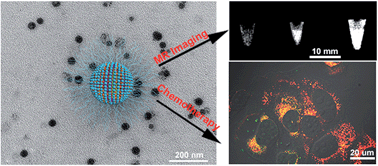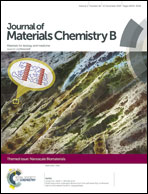Theranostic nanoscale coordination polymers for magnetic resonance imaging and bisphosphonate delivery†
Abstract
Nanoscale coordination polymers (NCPs) are self-assembled from metal ions and organic bridging ligands. The tunable compositions, sizes, and shapes; high drug loadings; ease of surface modification; and intrinsic biodegradability make NCPs great candidates for nanomedicine applications. Here we report the self-assembly of a Mn-bisphosphonate NCP that carries exceptionally high loadings of zoledronate (63 ± 5 wt%) and Mn2+ ions (13 ± 4 wt%) for potential cancer therapy and magnetic resonance imaging, respectively. The Mn-bisphosphonate NCP was further coated with lipid and pegylated to control the drug release kinetics and functionalized with a targeting group (anisamide) to endow specificity to cancer cells, leading to significantly enhanced cytotoxicity against human breast and pancreatic cancer cells. In vitro MR imaging studies demonstrated the efficacy of the Mn-bisphosphonate NCP as an effective T1 contrast agent and confirmed the targeting capability of anisamide-functionalized NCP. Multifunctional NCPs thus present an excellent platform for designing theranostic nanomaterials for a wide range of biomedical applications.

- This article is part of the themed collection: Nanoscale Biomaterials


 Please wait while we load your content...
Please wait while we load your content...